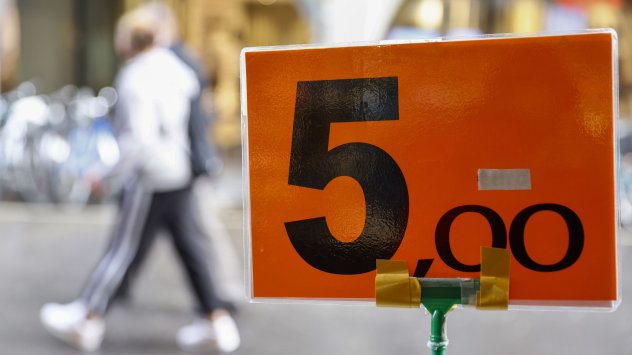
By Dimitar Sabev
Economists were surprised by global price rises in 2022 - says the International Monetary Fund in its latest State of the World Economy survey. After a decade of zero interest rates, being "surprised" by inflation is, to put it mildly, very odd. The fiscal stimulus following the post-Cold War pandemic amid the war-induced energy crisis in Ukraine has added fuel to the fire of generalized appreciation.
But the inflation of 2022 is not just explained by cooler monetary policy and more expensive fuels. Two other fundamental factors will not just go away in the coming years but will become more significant and probably forever deprive us of the dubious privilege of low prices for mass goods and services. We are talking about environmental externalities and the rise in the price of labor in the world's factories.
The economic term 'externalities' refers to the unintended consequences for third parties of some economic activity - e.g., spraying fields with insecticides leads to the death of bee colonies in the surrounding area; scarcer and more expensive honey is one of the externalities of factory farming, another is the difficulty of pollination. There are also positive externalities - e.g., water basins used for cooling power stations are warmer than usual and provide good conditions for fishing. But the general rule is that externalities are negative, i.e., harmful.
Negative environmental externalities were, until recently, free for business. In other words, the prices of goods did not include the environmental damages of their production they were causing. An authoritative 2013 study showed that none of the world's top 20 regional industries - coal power in China and the US, cattle ranching in South America, rice farming in Southeast Asia, etc. - would be profitable if companies paid the full environmental cost of their production. The cost includes emissions, land cover change, water use, pollution, and waste generation.
The British consultancy Trucost estimates the total externalities in primary production and processing at 13% of global GDP. Accordingly, if the world's businesses - the same as all the world's consumers - paid the true environmental price of the products they produce and consume, prices would be 13% higher today.
The IMF estimates that global inflation in 2022 will be 8.8%, so even without central banks, government spending, and Russia's invasion of Ukraine, we would face even higher inflation than we do now if we had to pay out of pocket for the damage we are causing with our production, consumption, and waste.
As we live on planet with limited size and resources, this situation will not continue indefinitely. There is increasing pressure for someone to take responsibility for the 'externalities'. The most advanced process is the valuation of carbon emissions, the market for which in 2021 is estimated at $851 billion, 90% of which is borne by the EU. China is also introducing a similar scheme; the emissions allowance market in North America has exceeded $50 billion and continues to grow. This factor is already affecting mass market prices - and will do so increasingly.
The environmental damage is far from just emissions. UN international trade figures show that in 2021 countries in the Americas exported $66 billion worth of meat and meat products, with exports from Brazil alone worth $20 billion. Brazilian beef is of excellent quality and is available at an acceptable price around the world - but this 'acceptable' price does not include the global effect of its production through the clearing of rainforests and conversion to pasture.
Scientists say that around 17% of the Amazon jungle has already been lost; if deforestation reaches 25%, a tipping point will be passed, leading to temperatures rising by up to 4 degrees, turning large parts of Brazil into a barren wasteland. It is also estimated that Amazonia will lose 27% of its tree cover at the current rate of deforestation by 2030.
These projections paint a formidable outlook, but let us limit our thoughts to their effect on market prices. There are two possible scenarios: either the rate of deforestation will be slowed by ambitious environmental policies, meaning less supply and more expensive meat, or the production binge will continue as long as possible - but then the material damage from the coming environmental crisis will also increase. All those damages will be calculated in costs and expenditures - and the dream of cheap steaks becomes unattainable again.
Carbon emissions and cattle farming are just two examples. As the world's population continues to grow, as ecosystems become industrial wastelands, as the aspirations of the so-called Third World rise, more and more things will happen that lead to higher prices: either policy to 'internalize externalities' will drive up costs, or where there are no such policies, environmental damage (and objective scarcity) will drive prices up.
Let us also say a few words about cheap labor. Since Karl Marx, the 'global caravan of business has been going on: multinationals seek the lowest costs and will not hesitate to shift production abroad if they can pay lower wages there. For decades, even centuries, this postulate has been the lever of business against both higher taxation and aggressive trade union movements. If workers in Germany want too much - we'll go to Poland, where wages are lower, then to Romania, Moldova, Southeast Asia...
Although it might be a strong argument, what will happen when business is already in Southeast Asia and labor costs start to rise there? Africa? Antarctica? Manufacturing requires not only labor and technology but also infrastructure, in which category, besides roads and the power grid, educational institutions fall. In some countries, production will not be cheap, even if labor is very cheap.
Malaysia and Thailand have long ceased to be low-wage countries. In Vietnam - one of the last bastions of cheap labor - average real wages have risen by about 50% in the last ten years; those employed in foreign-invested businesses in major cities earn $500 a month, not counting the 13th salary. Between 2016 and 2020, industrial labor costs rose 30% in China to $6.5 per hour. In the same year, labor costs per hour in Bulgaria were also $6.5.
Of course, labor wages will remain different in different parts of the world for a long time to come, but wages in the $100-$200 range that were normal in emerging economies until recently are now on the way out. Businesses could no doubt replace many workers with robots, but this is unlikely to bring down market prices much: for one thing, more taxation will be needed to help those unemployed by automation. On the other hand, in societies torn by unemployment, the cost of providing security is rising.
To summarise: today, the prices of goods and services are rising, not least because they have remained unnaturally low for a long time. The rich world has lived cheaply, relying on the free nature of harmful environmental impacts and almost free labor in the global periphery. That was profitable for the Western mass consumer, but maintaining such a global economic model is no longer possible. More worryingly, the two fundamental factors' socio-economic consequences may prove far more severe than price inflation.
THE BOTTOM LINE Even without central banks, government spending, and the war in Ukraine, we would face even greater inflation than we do now if we had to pay for the damage we are causing with our production and consumption.



